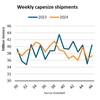Fujitsu, MPA to Curb Ship Collisions
Japanese multinational information technology equipment and services company Fujitsu Ltd and Maritime and Port Authority of Singapore (MPA) are testing technology that could give ship captains earlier warnings about potential collisions with other vessels.
A two-year field trial of the system has concluded, and further tests will be conducted before authorities decide whether to deploy the system, said a press release.
Fujitsu has demonstrated the usefulness of a novel ship collision risk prediction technology that leverages the power of Artificial Intelligence (AI) in predicting near misses between vessels.
Using AI technology "Fujitsu Human Centric AI Zinrai" developed by Fujitsu Laboratories Ltd, this solution can detect ship collision risks and predict areas where collision risks are concentrated as dynamic risk hotspots. This technology has the potential to be deployed in a Vessel Traffic Service (VTS) system to assist maritime traffic controllers to manage marine traffic proactively with the aim of improving the safety of navigation.
Fujitsu aims to deliver services incorporating this technology for maritime traffic controllers and ship operators by 2020.
Globally, especially in busy waterways, VTS centers that manage marine traffic rely on anti-collision warning in VTS systems, which uses closest point of approach techniques, to detect and notify ships when vessels get unusually close to one another.
As vessel operations and interactions become more complex, the ability to detect and predict vessel movements in advance, especially in high density vessel traffic areas like Singapore, is key to managing and reducing collision risks. To this end, Fujitsu and Fujitsu Laboratories have conducted research and development to calculate ship collision risks and predict dynamic hotspots.
Drawing on past traffic data for the Singapore Strait provided by MPA, Fujitsu leveraged its collision risk prediction technology to extract information such as examples of collisions or near misses involving multiple vessels, as well as examples of developing dynamic risk hotspots. The prediction technology was benchmarked to human operators.












